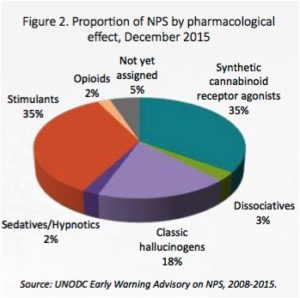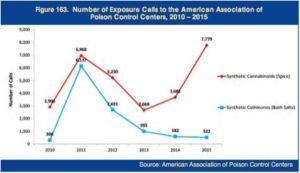In September of 2015 federal and city authorities raided around 80 locations throughout NYC in a crackdown on the importation, distribution and sale of synthetic cannabinoids. Ten people were indicted and a minimum of 100 kilograms of illegal synthetic compounds was confiscated. This was enough to produce 260,00 retail packets with a street value of near $30 million. The operation imported the compounds in powdered form from China through commercial delivery services (like UPS and Federal Express). Then in a Bronx processing facility, the compounds were mixed with solvents and sprayed onto tea leaves.
Most of the ten individuals indicted were of Yemeni descent; four were still at large at the time of the raid. One of the indicted, but at large, individuals seems to have tipped off his operation in July of 2014 when he was stopped for using a cell phone while driving. He consented to a search of his vehicle, where DEA agents found $644,338 IN CASH. When his Queens home was searched, they found an additional $150,935.
The agents say they then read Deiban his Miranda rights but that he nonetheless told them the greater sum came from the sale of synthetic narcotics and was bound for a store in the Bronx. They also say Deiban said the smaller sum came from Bronx and Queens stores that sell his synthetic pot.
He also boasted about selling his products over eBay. He was questioned about a number of keys he had on his person, some of which he said belonged to a warehouse where he stored his synthetic marijuana. But he was not willing to tell DEA agents the warehouse’s address unless the DEA agents guaranteed he would not go to jail. The case was settled in November of 2014. Under the terms, Deiban did not admit to any of the allegations and he was repaid $477,163.80 of the seized money.
Instead of counting his blessings, Deiban allegedly sought to make more dough. The September 2015 complaint says that in the past year, Deiban and his cronies imported at least 220 pounds of banned powdered substances used to make K2 or “spice”—enough to manufacture at least 260,000 packets.
The above incidents really happened, even though they seem to be suspiciously like an Onion satire of really dumb drug dealers. You can read the Department of Justice announcement of the September 2015 indictments here. Additional information noted above can be found in an article on The Daily Beast here and a New York Daily News article here.
This isn’t the first time there has been a Yemeni connection to the sale and distribution of synthetic cannabinoids in the U.S. In 2014, a raid on a Birmingham Alabama warehouse found hundreds of thousands of Spice (synthetic marijuana) packets. Sales of the product were linked to $40 million in wire transfers to Yemen. Read more about this in “Strange Bedfellows: Terrorists and Drugs.”
If you aren’t too familiar with Spice and other so-called new psychoactive substances (NPS), here are some key facts from a World Health Organization “fact file on new psychoactive substances.” There are more than 500 different types of NPS recorded as of March of 2016. The number of NPS as of October 2015 was 602, 55% higher than in 2014. By December 2015, that total would rise to over 644, according to the UNODC Global SMART Update. The most common NPS are synthetic cannabinoids, which mimic the effects of THC, the main psychoactive ingredient in marijuana. “Collecting information on new psychoactive substances is difficult due to the sheer number and speed with which they appear on the market.”
The UN Office on Drugs and Crime (UNODC), the lead agency in international drug control, has identified nine groups of new psychoactive substances. These include synthetic cannabinoids, which mimic the effects of the main psychoactive substance of cannabis, THC; synthetic cathinones, which have stimulant properties and induce feelings of empathy; and phenthylamines, which have stimulant and hallucinogenic properties. Of new psychoactive substances reported in 2014, 39 per cent were synthetic cannabinoids; 18 per cent were phenethylamines and 15 per cent were synthetic cathinones.
UNODOC publishes a Global SMART (Synthetics Monitoring: Analyses, Reporting and Trends) Update twice a year. Volume 16, published in September of 2016, said that synthetic drugs were one of the most significant global drug problems. As noted above over 644 NPS were reported from 102 different countries. “New NPS continue to emerge every year at an average rate of about one substance per week, making research and monitoring activities critical in improving understanding of the dynamic nature of the problem.” You can download a copy here.
NPS are diverse in terms of their effects and chemistry. Those identified so far seem to mimic the effects of the six main groups of substances controlled under international drug conventions. The six groups are: opioids, synthetic cannabinoid receptor agonists, dissociatives, like PCP, classical hallucinogens like LSD, sedatives/hypnotics like diazepam, and stimulants like cocaine and amphetamine-type stimulants. The following pie chart from the Global SMART Update illustrates the proportion of NPS by their pharmacological effect. The chart indicates how the three NPS noted above, synthetic cannabinoids, synthetic cathinones, and phenthylamines account for 88% of the total proportion of NPS indentified by December of 2015.
 A major area of concern is with the unknown adverse health risks associated with using NPS. Obtaining health-related and toxicological data is crucial for making scheduling decisions with NPS. Synthetic cannabinoids have been linked to both fatal and non-fatal intoxications, along with seizures, tachycardia and hypertension. Synthetic cathinones like MDPV have been associated with severe agitation, violent behavior, tachycardia, psychosis paranoia and fatal intoxications. Dangers are accentuated by intentional mislabeling of products, as was noted above, as well as their unknown purity and composition.
A major area of concern is with the unknown adverse health risks associated with using NPS. Obtaining health-related and toxicological data is crucial for making scheduling decisions with NPS. Synthetic cannabinoids have been linked to both fatal and non-fatal intoxications, along with seizures, tachycardia and hypertension. Synthetic cathinones like MDPV have been associated with severe agitation, violent behavior, tachycardia, psychosis paranoia and fatal intoxications. Dangers are accentuated by intentional mislabeling of products, as was noted above, as well as their unknown purity and composition.
The internet is an important distribution channel. It provides easy, anonymous and low-risk supply of NPS. Not to mention the high rewards to suppliers and retailers. Websites may be in different countries from those where the NPS are manufactured and/or where they are supplied. “The disparity of laws in various regions poses a challenge in adopting a comprehensive approach for the prosecution of violations.” Then there is the sale of products on the darknet, which is only accessed by anonymizing software.
The number of NPS and the rapidity with which new ones emerge presents a challenge to drug control systems. Placing a potentially harmful substance under legal control can be a lengthy process of evidence-gathering and a scientific review of its harms. This means there is a time lag between emergence of an NPS and when legal control is implemented. “NPS manufacturers o en exploit this inevitable me lag by developing and marketing alternative substances to circumvent established controls. “
In the U.S., the 2016 National Drug Threat Assessment (NDTA) reported that NPS are available throughout the U.S. The two most common are synthetic cannabinoids and synthetic cathinones. Although synthetic cannabinoids are usually ingested by smoking, they are also available as a liquid or oil to use in e-cigarettes or vape pens. In 2015, synthetic cannabinnoids were found in counterfeit Xanax bars. Calls to the AAPCC, the American Association of Poison Control Centers, totaled 7,779. This was a 111% increase over 2014. This was the highest number of calls recoded since the drugs first appeared on the market. See the following figure taken from the 2016 NDTA.
 Inmates in prisons and jails use synthetic cannabinoids because they aren’t typically tested for in mandatory drug screens. “The drugs are also difficult to detect during screenings by prison officials and narcotics dogs.” Liquid cannabiniods are sprayed onto paper products, like greeting cards or letters, and then dried. When successfully smuggled into a prison, the drug-saturated pages are torn into small squares, then chewed or smoked. In October of 2015, the FBI issued a warning that synthetic cannabioids in prisons may result in inmates becoming agitated and aggressive.
Inmates in prisons and jails use synthetic cannabinoids because they aren’t typically tested for in mandatory drug screens. “The drugs are also difficult to detect during screenings by prison officials and narcotics dogs.” Liquid cannabiniods are sprayed onto paper products, like greeting cards or letters, and then dried. When successfully smuggled into a prison, the drug-saturated pages are torn into small squares, then chewed or smoked. In October of 2015, the FBI issued a warning that synthetic cannabioids in prisons may result in inmates becoming agitated and aggressive.
The foil packets used to package synthetic cannabinoids can be purchased in bulk. The empty packets are already branded with various cartoon logos and brand names. The contents of the packets can vary widely. A DEA forensic lab tested 28 identical packets from one seizure in 2015. “The packets contained a total of seven different synthetic cannabinoids.” Many contained more than one variety of synthetic cannabinoid.
Ironically, the synthetic cannabinoid problem seems to have originated by classifying marijuana as a Schedule I controlled substance. In 1970, marijuana and its cannabinoids were given a Schedule I designation. This meant that marijuana was difficult to obtain for research on its therapeutic effects. Then John W. Huffman and his team of researchers at Clemson began developing cannabinoid compounds to aide in the research of multiple sclerosis, HIV/AIDS, and chemotherapy. Their research was funded by: the National Institute on Drug Abuse (NIDA).
Over the next twenty years, they developed 450 synthetic cannabinoid compounds. Some of those, including: JWH-018, JWH-073, JWH-210, JWH-250, and JWH-081 are among the dozens of synthetic cannabinoids on the streets today. Notice the compound names begin with Huffman’s initials: “JWH.” Like any self-respecting scientist, he published his research, which included step-by-step instructions on how to recreate the substances. Then around 2008, JWH-018 appeared in Germany as a recreational alternative for marijuana known as “Spice” and “K2.” Huffman said: “I always had a hunch that someday somebody would say, ‘Hey, let’s try smoking them.’ … These things are dangerous—anybody who uses them is playing Russian Roulette. . . . We never intended them for human consumption.”

